FIAT FREEMONT 2015 1.G Owners Manual
Manufacturer: FIAT, Model Year: 2015, Model line: FREEMONT, Model: FIAT FREEMONT 2015 1.GPages: 412, PDF Size: 3.37 MB
Page 381 of 412
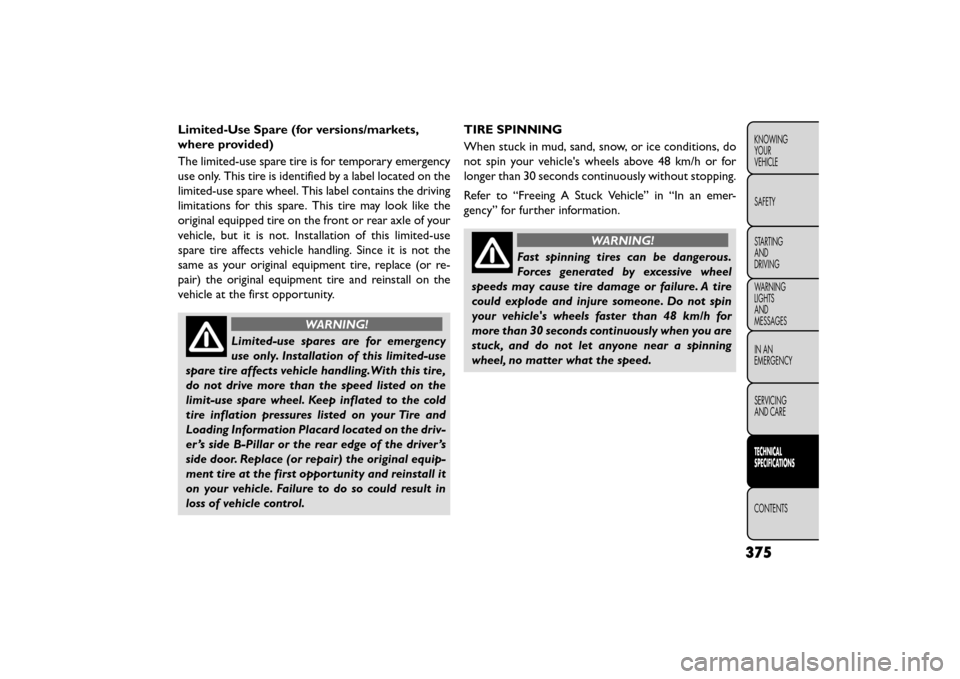
Limited-Use Spare (for versions/markets,
where provided)
The limited-use spare tire is for temporary emergency
use only. This tire is identified by a label located on the
limited-use spare wheel. This label contains the driving
limitations for this spare. This tire may look like the
original equipped tire on the front or rear axle of your
vehicle, but it is not. Installation of this limited-use
spare tire affects vehicle handling. Since it is not the
same as your original equipment tire, replace (or re-
pair) the original equipment tire and reinstall on the
vehicle at the first opportunity.
WARNING!
Limited-use spares are for emergency
use only .
Installation of this limited-use
spare tire affects vehicle handling.With this tire,
do not drive more than the speed listed on the
limit-use spare wheel. Keep inflated to the cold
tire inflation pressures listed on your Tire and
Loading Information Placard located on the driv-
er ’s side B-Pillar or the rear edge of the driver ’s
side door. Replace (or repair) the original equip-
ment tire at the first opportunity and reinstall it
on your vehicle. Failure to do so could result in
loss of vehicle control. TIRE SPINNING
When stuck in mud, sand, snow, or ice conditions, do
not spin your vehicle's wheels above 48 km/h or for
longer than 30 seconds continuously without stopping.
Refer to “Freeing A Stuck Vehicle” in “In an emer-
gency” for further information.
WARNING!
Fast spinning tires can be dangerous.
Forc es
generated by excessive wheel
speeds may cause tire damage or failure. A tire
could explode and injure someone. Do not spin
your vehicle's wheels faster than 48 km/h for
more than 30 seconds continuously when you are
stuck, and do not let anyone near a spinning
wheel, no matter what the speed.
375
KNOWING
YOUR
VEHICLE
SAFETY
STARTING
AND
DRIVING
WARNING
LIGHTS
AND
MESSAGES
IN AN
EMERGENCY
SERVICING
AND CARE
TECHNICAL
SPECIFICATIONS
CONTENTS
Page 382 of 412
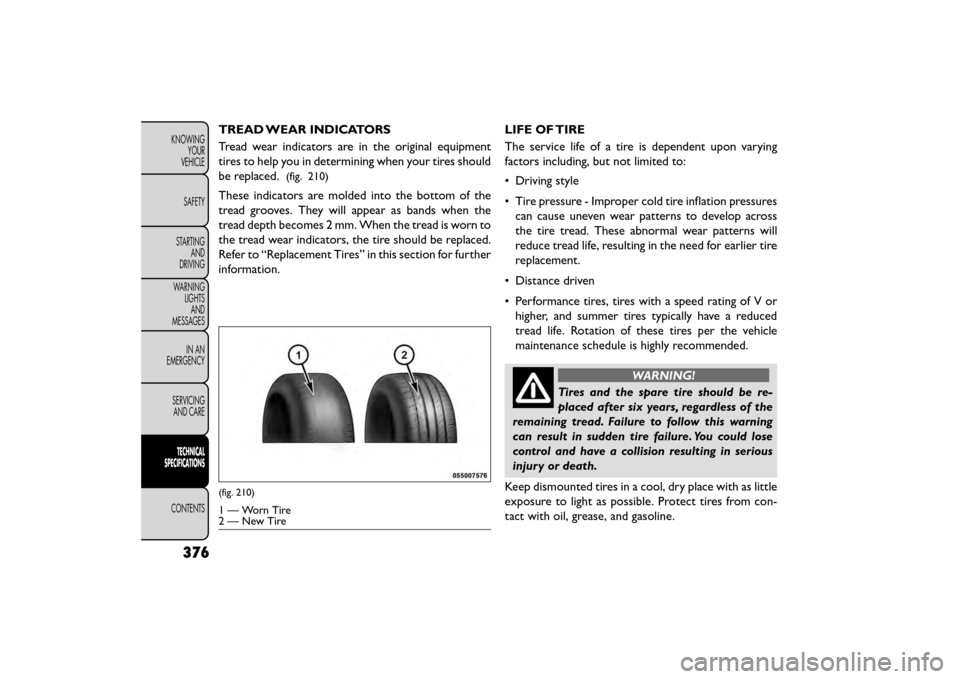
TREAD WEAR INDICATORS
Tread wear indicators are in the original equipment
tires to help you in determining when your tires should
be replaced.
(fig. 210)
These indicators are molded into the bottom of the
tread grooves. They will appear as bands when the
tread depth becomes 2 mm. When the tread is worn to
the tread wear indicators, the tire should be replaced.
Refer to “Replacement Tires” in this section for further
information.LIFE OF TIRE
The service life of a tire is dependent upon varying
factors including, but not limited to:
• Driving style
• Tire pressure - Improper cold tire inflation pressures
can cause uneven wear patterns to develop across
the tire tread. These abnormal wear patterns will
reduce tread life, resulting in the need for earlier tire
replacement.
• Distance driven
• Performance tires, tires with a speed rating of V or higher, and summer tires typically have a reduced
tread life. Rotation of these tires per the vehicle
maintenance schedule is highly recommended.
WARNING!
Tires and the spare tire should be re-
placed af
ter six years, regardless of the
remaining tread. Failure to follow this warning
can result in sudden tire failure. You could lose
control and have a collision resulting in serious
injury or death.
Keep dismounted tires in a cool, dry place with as little
exposure to light as possible. Protect tires from con-
tact with oil, grease, and gasoline.
(fig. 210)
1 — Worn Tire
2 — New Tire
376
KNOWING YOUR
VEHICLE
SAFETY
STARTING AND
DRIVING
WARNING LIGHTSAND
MESSAGES
IN AN
EMERGENCY
SERVICINGAND CARE
TECHNICAL
SPECIFICATIONS
CONTENTS
Page 383 of 412

REPLACEMENT TIRES
The tires on your new vehicle provide a balance of
many characteristics. They should be inspected regu-
larly for wear and correct cold tire inflation pressures.
The manufacturer strongly recommends that you use
tires equivalent to the originals in size, quality and
performance when replacement is needed. Refer to the
paragraph on “Tread Wear Indicator.” Refer to the Tire
and Loading Information placard or the Vehicle Certi-
fication Label for the size designation of your tire. The
Load Index and Speed Symbol for your tire will be
found on the original equipment tire sidewall. See the
Tire Sizing Chart example found in the Tire Safety
Information section of this manual for more informa-
tion relating to the Load Index and Speed Symbol of a
tire.
It is recommended to replace the two front tires or
two rear tires as a pair. Replacing just one tire can
seriously affect your vehicle’s handling. If you ever
replace a wheel, make sure that the wheel’s specifica-
tions match those of the original wheels.It is recommended you contact your authorized tire
dealer or original equipment dealer with any questions
you may have on tire specifications or capability. Failure
to use equivalent replacement tires may adversely af-
fect the safety, handling, and ride of your vehicle.
WARNING!
• Do not use a tire, wheel size or rating
ot h
er than that specified for your ve-
hicle. Some combinations of unapproved tires
and wheels may change suspension dimensions
and performance characteristics, resulting in
changes to steering, handling, and braking of your
vehicle. This can cause unpredictable handling
and stress to steering and suspension compo-
nents.You could lose control and have a collision
resulting in serious injury or death. Use only the
tire and wheel sizes with load ratings approved
for your vehicle.
• Never use a tire with a smaller load index or
capacity, other than what was originally
equipped on your vehicle. Using a tire with a
smaller load index could result in tire overloading
and failure. You could lose control and have a
collision.
(Continued)
377
KNOWING
YOUR
VEHICLE
SAFETY
STARTING
AND
DRIVING
WARNING
LIGHTS
AND
MESSAGES
IN AN
EMERGENCY
SERVICING
AND CARE
TECHNICAL
SPECIFICATIONS
CONTENTS
Page 384 of 412
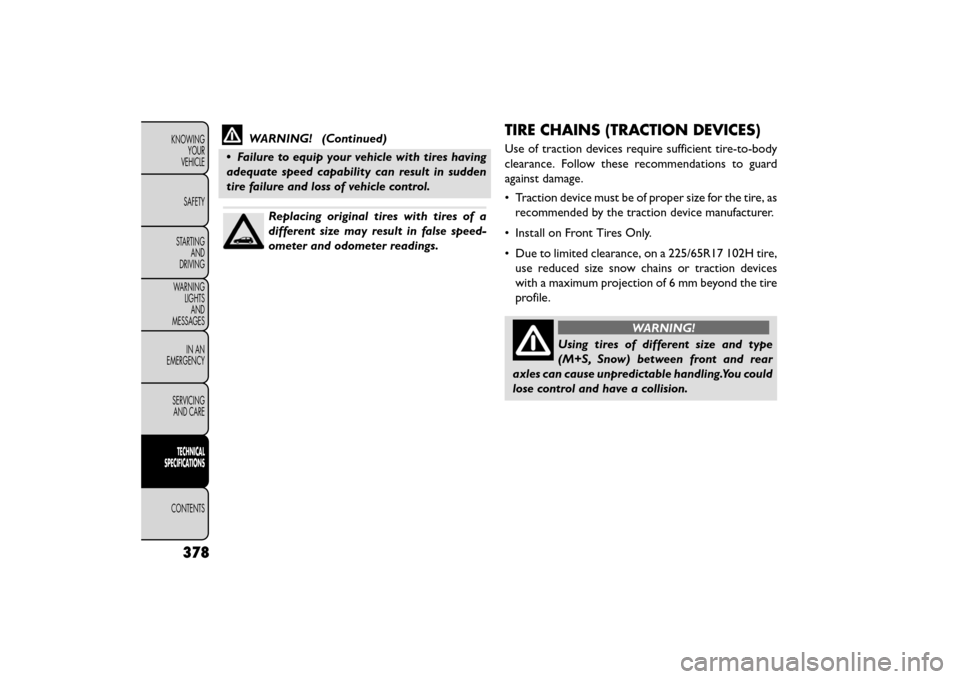
WARNING! (Continued)
• Failure to equip your vehicle with tires having
adequate speed capability can result in sudden
tire failure and loss of vehicle control.
Replacing original tires with tires of a
different size may result in false speed-
ometer and odometer readings.
TIRE CHAINS (TRACTION DEVICES)
Use of traction devices require sufficient tire-to-body
clearance. Follow these recommendations to guard
against damage.
• Traction device must be of proper size for the tire, as recommended by the traction device manufacturer.
• Install on Front Tires Only.
• Due to limited clearance, on a 225/65R17 102H tire, use reduced size snow chains or traction devices
with a maximum projection of 6 mm beyond the tire
profile.
WARNING!
Using tires of different size and type
(M+S, Sn
ow) between front and rear
axles can cause unpredictable handling.You could
lose control and have a collision.
378
KNOWING YOUR
VEHICLE
SAFETY
STARTING AND
DRIVING
WARNING LIGHTSAND
MESSAGES
IN AN
EMERGENCY
SERVICINGAND CARE
TECHNICAL
SPECIFICATIONS
CONTENTS
Page 385 of 412
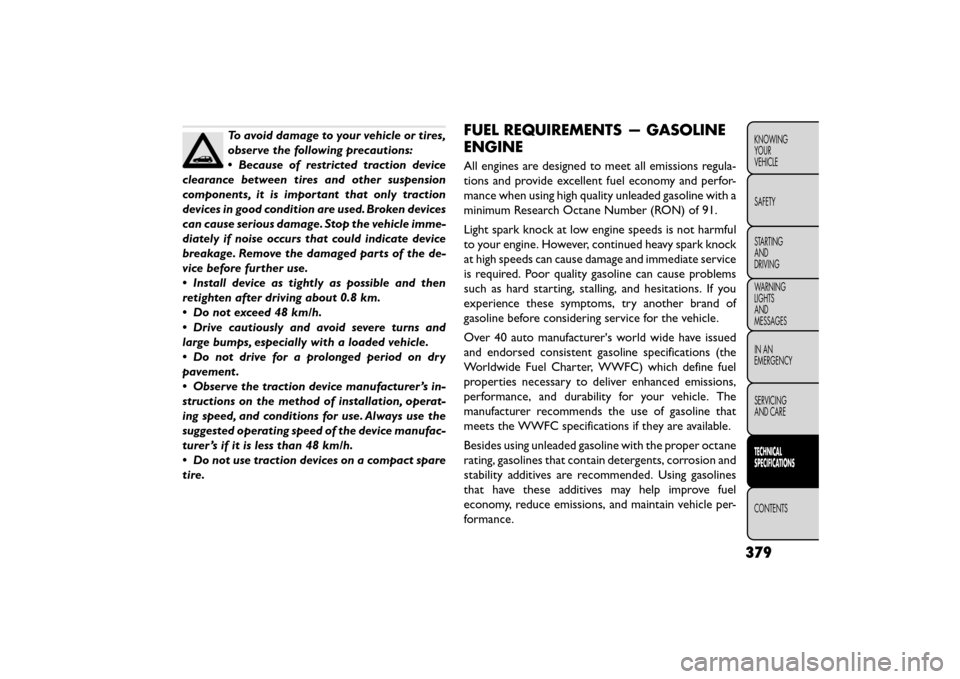
To avoid damage to your vehicle or tires,
observe the following precautions:
•Because of restricted traction device
clearance between tires and other suspension
components, it is important that only traction
devices in good condition are used. Broken devices
can cause serious damage. Stop the vehicle imme-
diately if noise occurs that could indicate device
breakage. Remove the damaged parts of the de-
vice before further use.
• Install device as tightly as possible and then
retighten after driving about 0.8 km.
• Do not exceed 48 km/h.
• Drive cautiously and avoid severe turns and
large bumps, especially with a loaded vehicle.
• Do not drive for a prolonged period on dry
pavement .
• Observe the traction device manufacturer ’s in-
structions on the method of installation, operat-
ing speed, and conditions for use. Always use the
suggested operating speed of the device manufac-
turer ’s if it is less than 48 km/h.
• Do not use traction devices on a compact spare
tire.FUEL REQUIREMENTS — GASOLINE
ENGINE
All engines are designed to meet all emissions regula-
tions and provide excellent fuel economy and perfor-
mance when using high quality unleaded gasoline with a
minimum Research Octane Number (RON) of 91.
Light spark knock at low engine speeds is not harmful
to your engine. However, continued heavy spark knock
at high speeds can cause damage and immediate service
is required. Poor quality gasoline can cause problems
such as hard starting, stalling, and hesitations. If you
experience these symptoms, try another brand of
gasoline before considering service for the vehicle.
Over 40 auto manufacturer's world wide have issued
and endorsed consistent gasoline specifications (the
Worldwide Fuel Charter, WWFC) which define fuel
properties necessary to deliver enhanced emissions,
performance, and durability for your vehicle. The
manufacturer recommends the use of gasoline that
meets the WWFC specifications if they are available.
Besides using unleaded gasoline with the proper octane
rating, gasolines that contain detergents, corrosion and
stability additives are recommended. Using gasolines
that have these additives may help improve fuel
economy, reduce emissions, and maintain vehicle per-
formance.
379
KNOWING
YOUR
VEHICLE
SAFETY
STARTING
AND
DRIVING
WARNING
LIGHTS
AND
MESSAGES
IN AN
EMERGENCY
SERVICING
AND CARE
TECHNICAL
SPECIFICATIONS
CONTENTS
Page 386 of 412
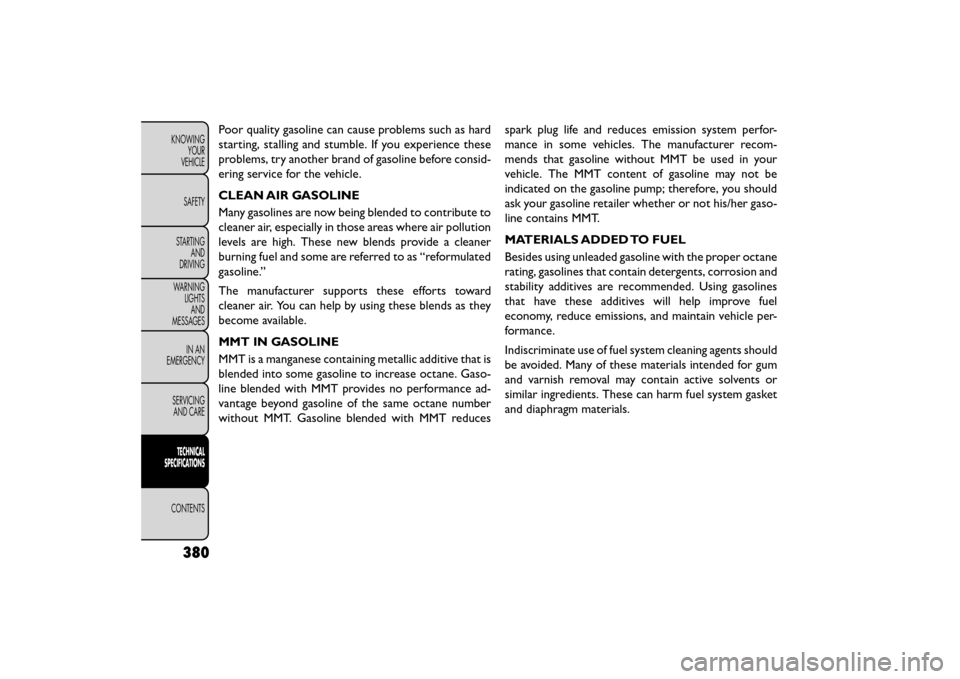
Poor quality gasoline can cause problems such as hard
starting, stalling and stumble. If you experience these
problems, try another brand of gasoline before consid-
ering service for the vehicle.
CLEAN AIR GASOLINE
Many gasolines are now being blended to contribute to
cleaner air, especially in those areas where air pollution
levels are high. These new blends provide a cleaner
burning fuel and some are referred to as “reformulated
gasoline.”
The manufacturer supports these efforts toward
cleaner air. You can help by using these blends as they
become available.
MMT IN GASOLINE
MMT is a manganese containing metallic additive that is
blended into some gasoline to increase octane. Gaso-
line blended with MMT provides no performance ad-
vantage beyond gasoline of the same octane number
without MMT. Gasoline blended with MMT reducesspark plug life and reduces emission system perfor-
mance in some vehicles. The manufacturer recom-
mends that gasoline without MMT be used in your
vehicle. The MMT content of gasoline may not be
indicated on the gasoline pump; therefore, you should
ask your gasoline retailer whether or not his/her gaso-
line contains MMT.
MATERIALS ADDED TO FUEL
Besides using unleaded gasoline with the proper octane
rating, gasolines that contain detergents, corrosion and
stability additives are recommended. Using gasolines
that have these additives will help improve fuel
economy, reduce emissions, and maintain vehicle per-
formance.
Indiscriminate use of fuel system cleaning agents should
be avoided. Many of these materials intended for gum
and varnish removal may contain active solvents or
similar ingredients. These can harm fuel system gasket
and diaphragm materials.
380
KNOWING
YOUR
VEHICLE
SAFETY
STARTING AND
DRIVING
WARNING LIGHTSAND
MESSAGES
IN AN
EMERGENCY
SERVICINGAND CARE
TECHNICAL
SPECIFICATIONS
CONTENTS
Page 387 of 412
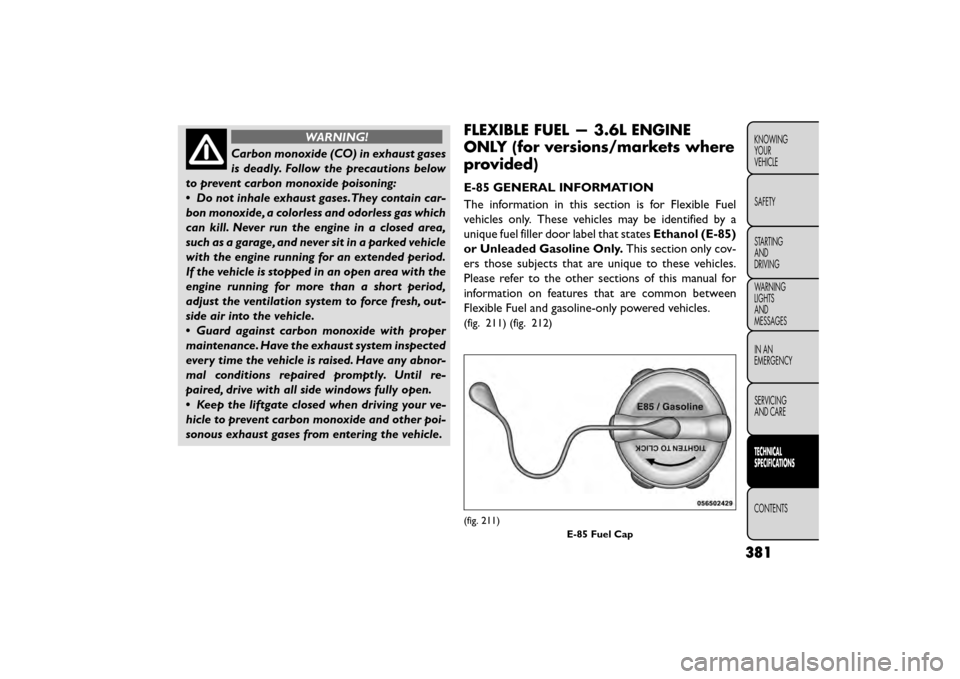
WARNING!
Carbon monoxide (CO) in exhaust gases
is deadly .
Follow the precautions below
to prevent carbon monoxide poisoning:
• Do not inhale exhaust gases.They contain car-
bon monoxide, a colorless and odorless gas which
can kill. Never run the engine in a closed area,
such as a garage, and never sit in a parked vehicle
with the engine running for an extended period.
If the vehicle is stopped in an open area with the
engine running for more than a short period,
adjust the ventilation system to force fresh, out-
side air into the vehicle.
• Guard against carbon monoxide with proper
maintenance. Have the exhaust system inspected
every time the vehicle is raised. Have any abnor-
mal conditions repaired promptly. Until re-
paired, drive with all side windows fully open.
• Keep the liftgate closed when driving your ve-
hicle to prevent carbon monoxide and other poi-
sonous exhaust gases from entering the vehicle.
FLEXIBLE FUEL — 3.6L ENGINE
ONLY (for versions/markets where
provided)
E-85 GENERAL INFORMATION
The information in this section is for Flexible Fuel
vehicles only. These vehicles may be identified by a
unique fuel filler door label that states Ethanol (E-85)
or Unleaded Gasoline Only. This section only cov-
ers those subjects that are unique to these vehicles.
Please refer to the other sections of this manual for
information on features that are common between
Flexible Fuel and gasoline-only powered vehicles.
(fig. 211) (fig. 212)
(fig. 211)
E-85 Fuel Cap
381
KNOWING
YOUR
VEHICLE
SAFETY
STARTING
AND
DRIVING
WARNING
LIGHTS
AND
MESSAGES
IN AN
EMERGENCY
SERVICING
AND CARE
TECHNICAL
SPECIFICATIONS
CONTENTS
Page 388 of 412
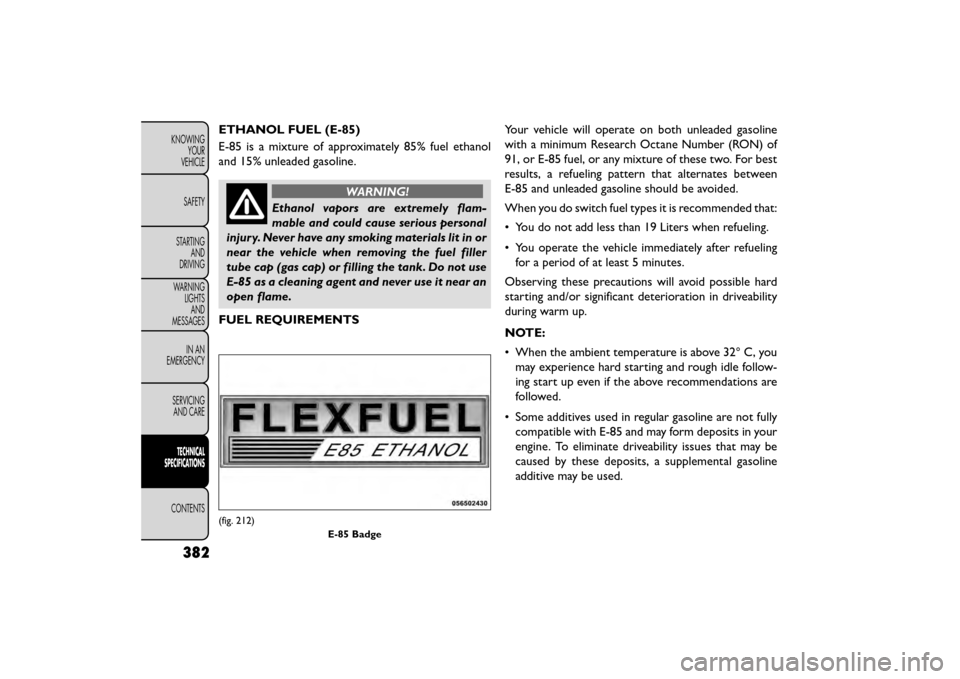
ETHANOL FUEL (E-85)
E-85 is a mixture of approximately 85% fuel ethanol
and 15% unleaded gasoline.
WARNING!
Ethanol vapors are extremely flam-
mable an
d could cause serious personal
injury. Never have any smoking materials lit in or
near the vehicle when removing the fuel filler
tube cap (gas cap) or filling the tank. Do not use
E-85 as a cleaning agent and never use it near an
open flame.
FUEL REQUIREMENTS Your vehicle will operate on both unleaded gasoline
with a minimum Research Octane Number (RON) of
91, or E-85 fuel, or any mixture of these two. For best
results, a refueling pattern that alternates between
E-85 and unleaded gasoline should be avoided.
When you do switch fuel types it is recommended that:
• You do not add less than 19 Liters when refueling.
• You operate the vehicle immediately after refueling
for a period of at least 5 minutes.
Observing these precautions will avoid possible hard
starting and/or significant deterioration in driveability
during warm up.
NOTE:
• When the ambient temperature is above 32° C, you may experience hard starting and rough idle follow-
ing start up even if the above recommendations are
followed.
• Some additives used in regular gasoline are not fully compatible with E-85 and may form deposits in your
engine. To eliminate driveability issues that may be
caused by these deposits, a supplemental gasoline
additive may be used.
(fig. 212)
E-85 Badge
382
KNOWINGYOUR
VEHICLE
SAFETY
STARTING AND
DRIVING
WARNING LIGHTSAND
MESSAGES
IN AN
EMERGENCY
SERVICINGAND CARE
TECHNICAL
SPECIFICATIONS
CONTENTS
Page 389 of 412
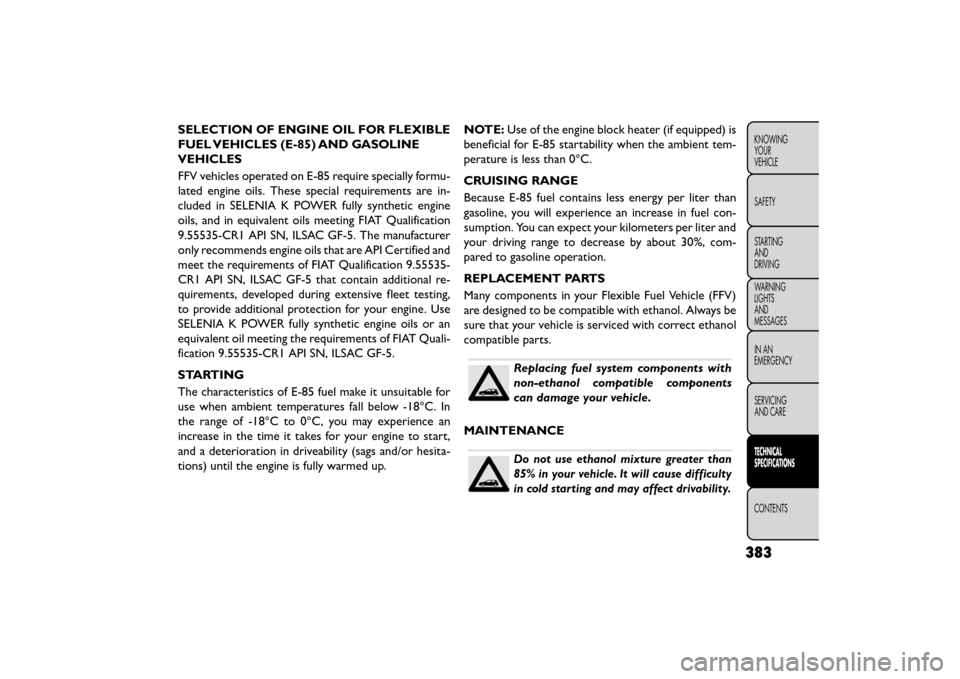
SELECTION OF ENGINE OIL FOR FLEXIBLE
FUEL VEHICLES (E-85) AND GASOLINE
VEHICLES
FFV vehicles operated on E-85 require specially formu-
lated engine oils. These special requirements are in-
cluded in SELENIA K POWER fully synthetic engine
oils, and in equivalent oils meeting FIAT Qualification
9.55535-CR1 API SN, ILSAC GF-5. The manufacturer
only recommends engine oils that are API Certified and
meet the requirements of FIAT Qualification 9.55535-
CR1 API SN, ILSAC GF-5 that contain additional re-
quirements, developed during extensive fleet testing,
to provide additional protection for your engine. Use
SELENIA K POWER fully synthetic engine oils or an
equivalent oil meeting the requirements of FIAT Quali-
fication 9.55535-CR1 API SN, ILSAC GF-5.
STARTING
The characteristics of E-85 fuel make it unsuitable for
use when ambient temperatures fall below -18°C. In
the range of -18°C to 0°C, you may experience an
increase in the time it takes for your engine to start,
and a deterioration in driveability (sags and/or hesita-
tions) until the engine is fully warmed up.NOTE:
Use of the engine block heater (if equipped) is
beneficial for E-85 startability when the ambient tem-
perature is less than 0°C.
CRUISING RANGE
Because E-85 fuel contains less energy per liter than
gasoline, you will experience an increase in fuel con-
sumption. You can expect your kilometers per liter and
your driving range to decrease by about 30%, com-
pared to gasoline operation.
REPLACEMENT PARTS
Many components in your Flexible Fuel Vehicle (FFV)
are designed to be compatible with ethanol. Always be
sure that your vehicle is serviced with correct ethanol
compatible parts.
Replacing fuel system components with
non-ethanol compatible components
can damage your vehicle.
MAINTENANCE
Do not use ethanol mixture greater than
85% in your vehicle. It will cause difficulty
in cold starting and may affect drivability.
383
KNOWING
YOUR
VEHICLE
SAFETY
STARTING
AND
DRIVING
WARNING
LIGHTS
AND
MESSAGES
IN AN
EMERGENCY
SERVICING
AND CARE
TECHNICAL
SPECIFICATIONS
CONTENTS
Page 390 of 412
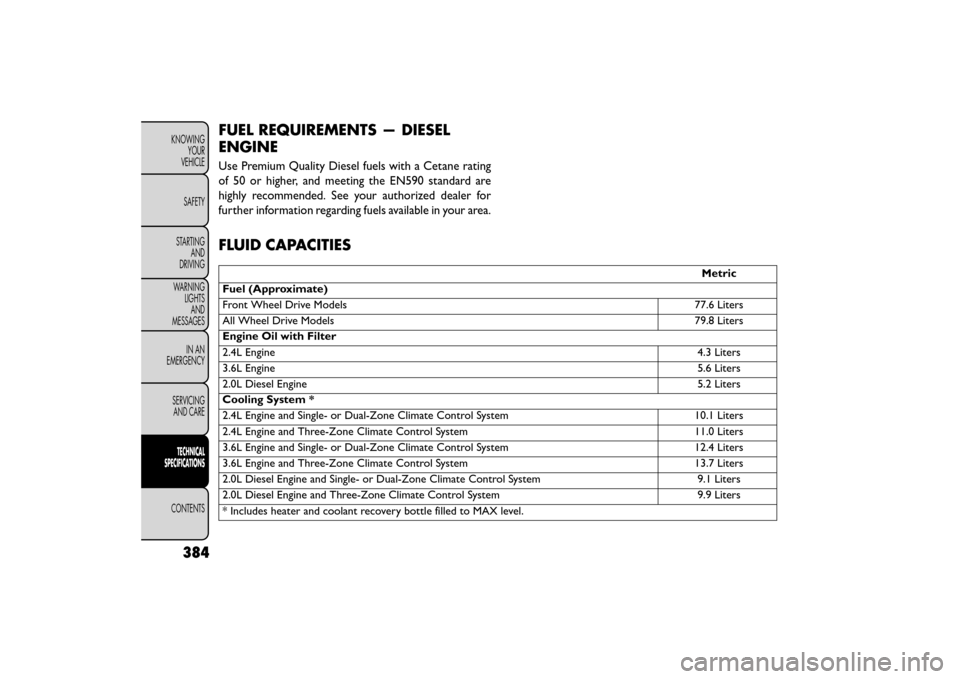
FUEL REQUIREMENTS — DIESEL
ENGINE
Use Premium Quality Diesel fuels with a Cetane rating
of 50 or higher, and meeting the EN590 standard are
highly recommended. See your authorized dealer for
further information regarding fuels available in your area.
FLUID CAPACITIES
Metric
Fuel (Approximate)
Front Wheel Drive Models 77.6 Liters
All Wheel Drive Models 79.8 Liters
Engine Oil with Filter
2.4L Engine 4.3 Liters
3.6L Engine 5.6 Liters
2.0L Diesel Engine 5.2 Liters
Cooling System *
2.4L Engine and Single- or Dual-Zone Climate Control System 10.1 Liters
2.4L Engine and Three-Zone Climate Control System 11.0 Liters
3.6L Engine and Single- or Dual-Zone Climate Control System 12.4 Liters
3.6L Engine and Three-Zone Climate Control System 13.7 Liters
2.0L Diesel Engine and Single- or Dual-Zone Climate Control System 9.1 Liters
2.0L Diesel Engine and Three-Zone Climate Control System 9.9 Liters
* Includes heater and coolant recovery bottle filled to MAX level.
384
KNOWING YOUR
VEHICLE
SAFETY
STARTING AND
DRIVING
WARNING LIGHTSAND
MESSAGES
IN AN
EMERGENCY
SERVICINGAND CARE
TECHNICAL
SPECIFICATIONS
CONTENTS